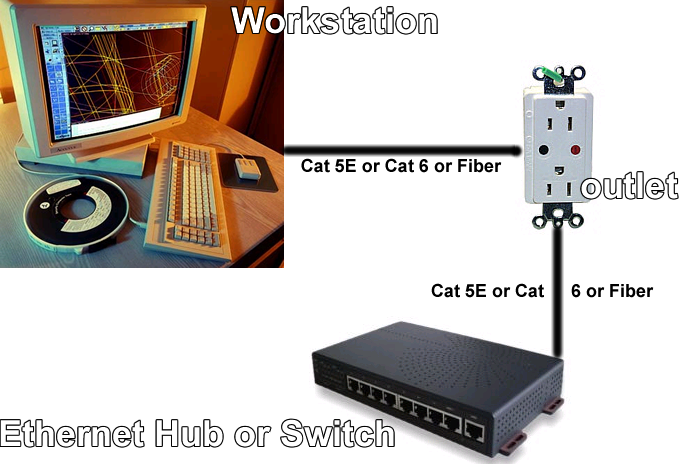 ALLIED CABLE
ALLIED CABLE ALLIED CABLE
ALLIED CABLE

Data
Private Networks, new and existing, must be well planned and carefully structured. Their network cabling solution may require a balance of both copper and fiber to cost effectively meet today's needs and support the high-bandwidth applications of the future, such as multimedia and full motion digital video-conferencing.Rapidly evolving applications and technologies will drastically increase the speed and volume of traffic on WAN/LAN networks. Ensuring that your structured cabling solution is designed to accommodate the higher transmission rates associated with these evolving bandwidth intensive
applications will be critical. Some examples include:
Local Area Networks (LANs)
A LAN is a data communications system that enables users to access common data processing (PCs, minicomputers, and mainframe computers) and peripheral equipment (printers and fax machines). LANs are created by using workstations with adapter cards and connecting them to file servers (where the operating system/software resides) and printers. Gateways are used to connect LANs to other LANs or operating systems like large mainframes where there is a need to share departmental or corporate computing systems. A LAN can be as simple as a few workstations working off a file server or as complex as putting hundreds of workstations on a network that runs between floors of a building or between a number of buildings in a campus environment. LANs, which were originally designed so that users could share and access a few expensive printers or controllers, have expanded into essential telecommunications networks. Today, LANs are used for file and printer sharing, electronic mail, shared databases, point-of-sale, and order entry systems.
LANs deployed on different floors or buildings are typically connected with multimode fiber, However, newer high-speed LAN topologies like full motion video do utilize singlemode fiber in some long-distance route applications where the superior transmission characteristics of singlemode fiber are required. Allied installs fiber optic products installed in office buildings, factories, hospitals, stores, and banks, in a comprehensive, fiber-based product line featuring cabling solutions for all areas of the LANs including the campus, riser/backbone, and Fiber-to-the-Desktop. Nobody understands networking and connectivity like Allied Cable.
LAN Topologies
Allied offers cabling architecture options for Fiber-to-the-Desktop installations: the traditional Hierarchical Star architecture and the new Single Point Administration architecture . Each has advantages which must be considered when choosing a fiber cabling system. Offering both architecture options allows additional design flexibility to meet our customers' needs in the most cost- effective ways.
The traditional Hierarchical Star architecture is designed for maximum flexibility. Cross-connect facilities are provided in both the telecommunications closets and the main equipment room. The riser backbone cables can be sized with low counts which allow only distributed active equipment, or for greatest flexibility, with high counts which permit both distributed and centralize active equipment. The horizontal cross-connect facility ensures the greatest life span for the system by allowing the active equipment to be located closer to the work areas. The short horizontal runs can support applications at higher speeds than the longer combined horizontal/riser runs used with centralized active equipment. Also, this architecture is standards-compliant with both riser design approaches.
Single Point Administration architecture is designed for simplicity and cost- effectiveness for centralized equipment. This approach provides direct connections from all work areas (offices) to the cross-connect in the main equipment room, forming a single point of administration optimized for centralized active equipment. The single point of administration provides the simplest circuit management possible by eliminating the need to cross-connect circuits in multiple places. It also provides the ability to connect users in different areas of a building directly to the same LAN segment, reducing traffic on bottleneck-prone bridges and routers. Single point administration also provides three cost benefits. First, it eliminates the need for horizontal cross-connects, saving passive hardware costs. Second, it consolidates active equipment, reducing the number of idle ports in the system, thereby saving active equipment costs. Finally, this type of architecture eases network administration and maintenance, reducing technical support staff effort.
The LAN topology is the physical layout of a LAN--how the controllers, work- stations (primarily PCs), and other equipment are connected by the cable. The three basic LAN topologies are: Bus, Star, Ring.
The bus topology has all the workstations on the network attached (via the information outlet) to a single cable that carries the signal in both directions through the network. The bus network can be expanded by adding several segments together with bridges, routers and repeaters. Institute of Electrical and Electronics Inc. (IEEE) Standard 802.3 is an example of a bus topology. In a star topology, all of the nodes or workstations are connected with unshielded twisted pair (UTP) or fiber optic cable to a centrally located common controller or concentrator. The central control point permits centralized network administration, management, and troubleshooting. Star LAN is an example of a star topology, as is IEEE 802.3. In a ring topology, the network forms a ring. A token carries data through the network. Workstations are connected as in a star topology to a central administration point such as a multistation access unit (MAU). Token Ring (IEEE 802.5) is an example
of a ring topology.
The Lans, which were introduced back in the 1980s, were based on copper cable with very few fiber applications being used. Most of the more recently introduced LANs (FDDI, 1000 base T, and Sonnet) primarily use fiber optics but offer interfaces (bridges and routers) with the older copper-based networks. The more recent trend is in the use of ethernet switches. In addition, the backbone network, which links the ethernet together, could be on higher speed LAN topology such as 1000 base T. The advent of new lower cost optoelectronics for LAN applications has spurred a growing interest in using fiber all the way to the workstation. These total fiber networks offer easy migration to even higher speed applications.

ALLIED CABLE
Phone:(440)582-0111
Fax:(330)598-1114
Corporate Headquarters
800 W. Liberty
Medina, Ohio 44256